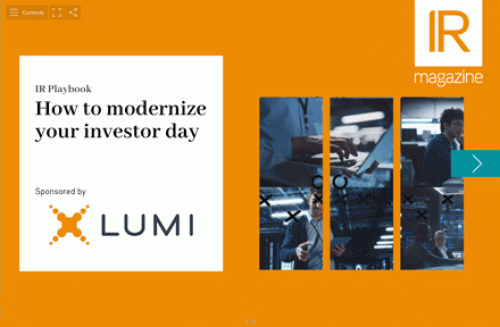Corporate access teams worldwide give advice on how IROs can make the most of the sell side when they hit the road
To be a potent force on tour, an IR professional needs to master investor targeting and contingency planning, and have lots of old-fashioned dedication. Non-deal roadshows are vital for firms looking to service existing shareholders and gain new ones. Without clear objectives, however, there is a risk the variety of potential targets can confuse brokers and service providers, endangering the quality of investor outreach. But pitfalls can be avoided.
1 Do your homework
A top-class non-deal roadshow requires a strategy grounded
in detailed knowledge. Use all available sources to maximize the depth of information you have at hand before you go. ‘Ahead of roadshows, a call with sales and the analyst will help you obtain possible question areas. This helps to better target your financial communication,’ says Bénédicte Thibord, head of marketing services at CA Cheuvreux.
‘Ask your hosting party (broker or IR firm) for pre-meeting intelligence on the investors,’ adds Deena Sullivan, vice president of business development at WJB Capital Group. ‘Important issues include investors’ general knowledge of the company and industry, historical ownership and investment considerations.’
2 Stick to your guns
Your objective for the roadshow must be pursued with conviction, says Cara Eio, executive director and co-head of corporate and investor access at Nomura. ‘Articulate your strategy and how you intend to get there,’ she advises. ‘Then execute, execute, execute.’
You need to tailor your geographical and institutional outreach to your objectives. For example, if you are looking for maximum coverage, Thibord recommends heading to where capital is most concentrated. ‘Visit the regions where assets under management are highest, such as the UK and the US, at least twice a year,’ she suggests.
3 Be in the loop
Do not sit back and leave all the details to your corporate access team. There is nothing more wasteful than an uncoordinated roadshow, and information-gathering needs to be a two-way process.
‘Request that the corporate access team justifies the timing and scope of the roadshow, and find out more about the potential investment and actual size of its targets,’ says Gibson Smith, head of US corporate access at Citi.
4 Maximize management’s time
It is crucial that management is thoroughly briefed ahead of the roadshow, and that team members meet the right people. ‘Do not waste your senior management’s time,’ warns Eio.
5 Meet the decision makers
While investors appreciate meaningful contact with senior management, it is also vital to maximize access to potential investors. ‘Ensure meetings are with the senior decision makers at each investment firm,’ recommends Danielle Poulain, head of corporate relations at UK-based independent broker Execution.
6 Stay up to date
The investment landscape is constantly changing. Using outdated information will waste everyone’s time so new research has to be conducted prior to every roadshow. ‘The broker should be asked to provide detailed advice based on its in-depth, up-to-date knowledge of the buy-side community,’ Poulain says. ‘Corporates should ask brokers to justify each recommendation so they can make a well-informed decision.’
7 Leave room for fine-tuning
It is important to keep a dialogue going with members of your corporate access team; they aren’t mind readers, after all. ‘Share with the corporate access team a list of investors you have most recently met with so as to avoid over-marketing to a particular investor,’ says Smith.
It is a difficult balancing act to get right, but using a broker’s wider advice on a region or industry sector can be very useful. ‘Resist preconceptions regarding certain institutions, such as hedge funds,’ says Thibord.
8 Best-laid plans
Even if you are trying to fit in 200 meetings, it is critical to make the most of each one, and the most efficient meetings are to be had with well-informed investors. ‘Email meeting participants your presentation at least 24 hours prior to the meeting,’ suggests Sullivan. ‘Hard copies are also strongly recommended.’
9 The after-show party
‘Following the meeting, interaction with the investor is not yet complete. Timely post-meeting feedback is a crucial element in the process,’ Sullivan notes. ‘Knowing the particular concerns investors addressed in previous meetings will help corporates get ahead of the issues and craft future presentations accordingly.’
In the current climate, with companies looking for security rather than short-term investors, the importance of quarterly relationship building cannot be overstated, and the flexibility of the non-deal roadshow provides opportunities to build for the future. ‘Garner feedback from your investors. It should be a two-way dialogue,’ says Eio.
10 Manage expectations
However ambitious you may be on the non-deal roadshow, Eio says the IR professional’s role is key. ‘Manage expectations: under-promise and over-deliver,’ she concludes.










